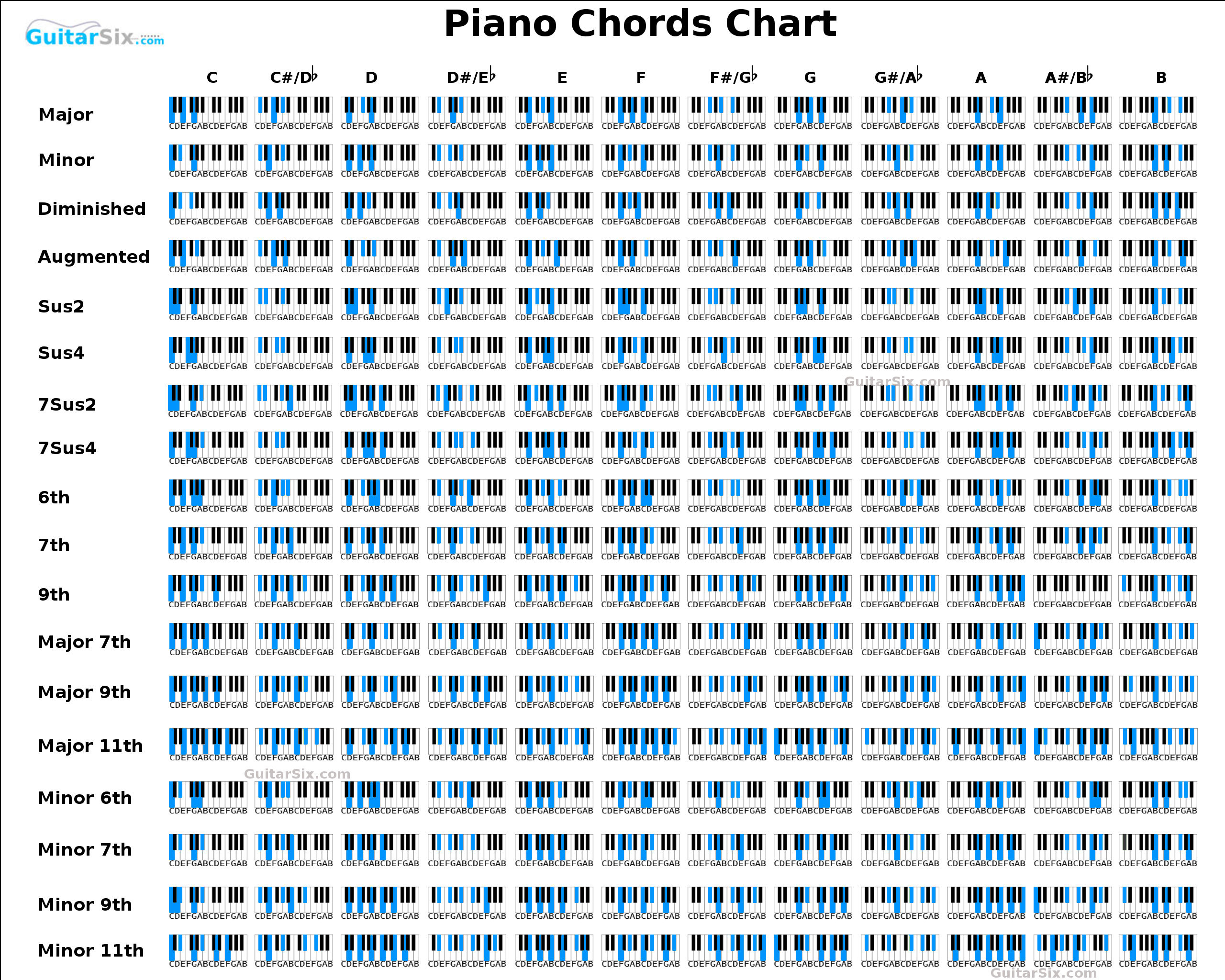
In this article, it will be explained what a chord is and which the most common categories of chords are. Playing piano is a big field and Perfectkeys does not primarily focus on chords and, therefore, you will not find any diagrams here for particular chords. In that case Pianochord.org could be recommended.
What is a chord?
A chord is several notes played together. There are three note chords (triads), four note chords and five note chords. There are actually even chords with six or seven notes, but in this case some of the notes are usually removed. It should also be mentioned that there exist chords with two notes (dyads), which are less common on piano. Chords are also related to scales, read about how chords is built from scales.
…And what are they good for?
Chords can, for example, tribute with harmony and structure. By harmony means that a chord adds bass notes to a melody and make it more full-flavored. By structure means that chords can add rhythm and variation to a melody. To create harmony a chord is often played simultaneously as a melody note and to create structure a chord is often played between melody notes.
Different chords
Major: a common triad is commonly written only by the name of the root of the chord.
For example C, including the notes C – E – G.
Minor: the common version of minor is commonly written with the name followed by a “m” (short for minor).
For example Cm, including C – Eb – G.
7: when the number seven is following the name of the note it is a dominant seventh chord. A minor seventh is added and make it a four note chord.
For example C7, including C – E – G – Bb.
m7: this is minor (m is an abbreviation for minor) seventh chord. A minor seventh is added to a minor triad.
For example Cm7, including C – Eb – G – Bb.
maj7: – this is a major (maj is an abbreviation for major) seventh chord. A major seventh in the scale is added to a major triad.
For example Cmaj7, including C – E – G – B.
7-5: this is a dominant seventh chord with a flattened fifth. This chord can also be written like 7b5.
For example C7b5, including C – E – Gb – Bb.
7+5: this is a dominant seventh chord with a sharp fifth. This chord can also be written like 7#5.
For example C7#5, including C – E – G# – Bb.
6: this is constructed from a triad with the sixth note in the scale being added.
For example C6, including C – E – G – A.
m6: this is is constructed from a minor triad with the sixth note added.
For example Cm6, including C – Eb – G – A.
9: here the ninth note in the scale is added to a dominant seventh chord.
For example C9, including C – E – G – Bb – D.
m9: here the ninth note in the scale is added to a minor seventh chord.
For example Cm9, including C – Eb – G – Bb – D.
maj9: here the ninth note in the scale is added to a major seventh chord.
For example Cmaj9, including C – E – G – B – D.
dim: is an abbreviation for diminished and the chords are diminished in the way the third and the fifth note are flattened. There is also diminished 7th with a flattened seventh note.
For example Cdim, including C – Eb – Gb or Cdim7, including C – Eb – Gb – A.
aug: is an abbreviation for augmented and the chords are augmented in the way the fifth note are sharpened.
For example Caug, including C – E – G# (the aug chord could also be written like C+).
sus: is an abbreviation for suspension. Here the third is replaced by either the fourth note (sus4) or the second note (sus2) in the scale.
For example Csus4, including C – F – G and Csus2, including C – D – G.
With the knowledge about the categories of chords explained above, you will be familiar with the most chords you could stumble upon. There are however even more categories and some lesser common chords are:
- Dominant, major and minor eleventh (for example: C11, Cmaj11 and Cm11)
- Dominant, major and minor thirteenth (for example: C13, Cmaj13 and Cm13)
- Half-diminished (for example: Cm7b5)
- Augmented seventh (for example: Caug7)
- Add9 (for example: Cadd9)
Inverted chords
Inverted chords are very common and mean that the notes in a chord are shifting positions. If we take triads as an example, there are two inversions possible. The first inversion uses the second note as bass note and the second inversion uses the third note as bass note.
The original chord, C Major is constructed C – E – G.
First inversion, C/E is constructed E – G – C.
Second inversion, C/G is constructed G – C – E.
Chords in practice
Exactly how you play chords will depend on many different things: are you playing solo, together with a singer or in a full band? If you play solo, you probably will play chords with your left hand and the melody with your right. If you are accompanying a singer, you would focus less on the melody notes and perhaps split up the chords on both your hands. And finally, if you would be playing with a band you would probably need to play fewer notes.
See also Theory: what is a scale?



